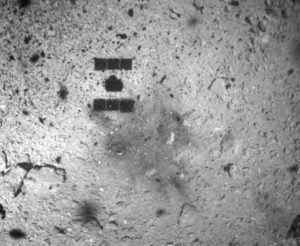Japan’s Aerospace Exploroation Agency (JAXA) said on Friday that its Hayabusa2 spacecraft has dropped an explosive on asteroid Ryugu  to form a crater to pave the way for the collection of of underground sample for possible clues to the origin of the solar system.
to form a crater to pave the way for the collection of of underground sample for possible clues to the origin of the solar system.
The agency said the mission was a very risky one as it had to immediately move Hayabusa2 away so it would not get hit by flying shards from the blast but in all, the mission was a success.
The agency stated that a group of scientist participating in the Hayabusa2 mission had detected hydroxyl-bearing minerals on the asteroid by analyzing near-infrared spectrometer readings by the spacecraft. It said that could help explain where the Earth’s water came from.





